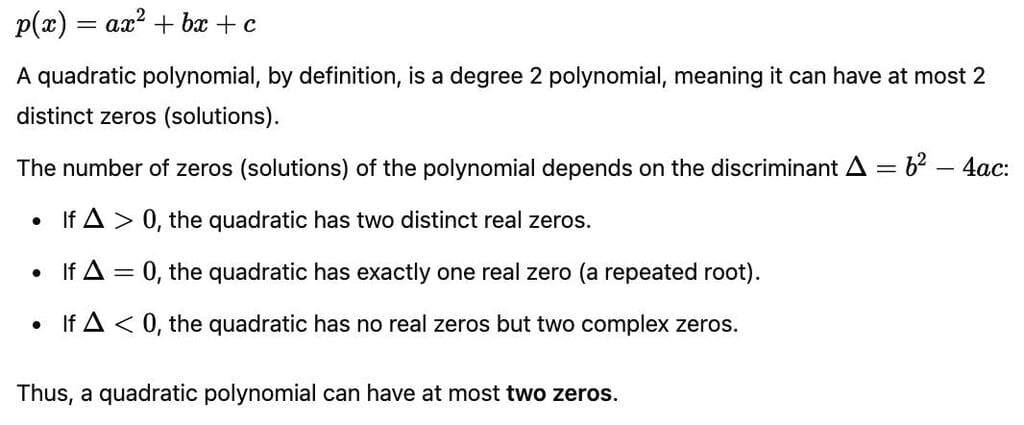UPSC Exam > UPSC Questions > Let p(x) = ax2+ bx + c be a quadratic polynom...
Start Learning for Free
Let p(x) = ax2 + bx + c be a quadratic polynomial. It can have at most –
- a)One zero
- b)Two zeros
- c)Three zeros
- d)None of these
Correct answer is option 'B'. Can you explain this answer?
Verified Answer
Let p(x) = ax2+ bx + c be a quadratic polynomial. It can have at most ...

Most Upvoted Answer
Let p(x) = ax2+ bx + c be a quadratic polynomial. It can have at most ...
The polynomial ax^2+bx+c has three terms. The first one is ax^2, the second is bx, and the third is c.
The exponent of the first term is 2.
The exponent of the second term is 1 because bx=bx^1.
The exponent of the third term is 0 because c=cx^0.
Since the highest exponent is 2, therefore, the degree of ax^2+bx+c is 2.
Since, the degree of the polynomial is 2, hence, the polynomial ax^2+bx+c can have zero, one or two zeroes.
Hence, the polynomial ax^2+bx+c can have at most two zereos.
Free Test
FREE
| Start Free Test |
Community Answer
Let p(x) = ax2+ bx + c be a quadratic polynomial. It can have at most ...
Two distinct roots.

|
Explore Courses for UPSC exam
|

|
Question Description
Let p(x) = ax2+ bx + c be a quadratic polynomial. It can have at most –a)One zerob)Two zerosc)Three zerosd)None of theseCorrect answer is option 'B'. Can you explain this answer? for UPSC 2025 is part of UPSC preparation. The Question and answers have been prepared according to the UPSC exam syllabus. Information about Let p(x) = ax2+ bx + c be a quadratic polynomial. It can have at most –a)One zerob)Two zerosc)Three zerosd)None of theseCorrect answer is option 'B'. Can you explain this answer? covers all topics & solutions for UPSC 2025 Exam. Find important definitions, questions, meanings, examples, exercises and tests below for Let p(x) = ax2+ bx + c be a quadratic polynomial. It can have at most –a)One zerob)Two zerosc)Three zerosd)None of theseCorrect answer is option 'B'. Can you explain this answer?.
Let p(x) = ax2+ bx + c be a quadratic polynomial. It can have at most –a)One zerob)Two zerosc)Three zerosd)None of theseCorrect answer is option 'B'. Can you explain this answer? for UPSC 2025 is part of UPSC preparation. The Question and answers have been prepared according to the UPSC exam syllabus. Information about Let p(x) = ax2+ bx + c be a quadratic polynomial. It can have at most –a)One zerob)Two zerosc)Three zerosd)None of theseCorrect answer is option 'B'. Can you explain this answer? covers all topics & solutions for UPSC 2025 Exam. Find important definitions, questions, meanings, examples, exercises and tests below for Let p(x) = ax2+ bx + c be a quadratic polynomial. It can have at most –a)One zerob)Two zerosc)Three zerosd)None of theseCorrect answer is option 'B'. Can you explain this answer?.
Solutions for Let p(x) = ax2+ bx + c be a quadratic polynomial. It can have at most –a)One zerob)Two zerosc)Three zerosd)None of theseCorrect answer is option 'B'. Can you explain this answer? in English & in Hindi are available as part of our courses for UPSC.
Download more important topics, notes, lectures and mock test series for UPSC Exam by signing up for free.
Here you can find the meaning of Let p(x) = ax2+ bx + c be a quadratic polynomial. It can have at most –a)One zerob)Two zerosc)Three zerosd)None of theseCorrect answer is option 'B'. Can you explain this answer? defined & explained in the simplest way possible. Besides giving the explanation of
Let p(x) = ax2+ bx + c be a quadratic polynomial. It can have at most –a)One zerob)Two zerosc)Three zerosd)None of theseCorrect answer is option 'B'. Can you explain this answer?, a detailed solution for Let p(x) = ax2+ bx + c be a quadratic polynomial. It can have at most –a)One zerob)Two zerosc)Three zerosd)None of theseCorrect answer is option 'B'. Can you explain this answer? has been provided alongside types of Let p(x) = ax2+ bx + c be a quadratic polynomial. It can have at most –a)One zerob)Two zerosc)Three zerosd)None of theseCorrect answer is option 'B'. Can you explain this answer? theory, EduRev gives you an
ample number of questions to practice Let p(x) = ax2+ bx + c be a quadratic polynomial. It can have at most –a)One zerob)Two zerosc)Three zerosd)None of theseCorrect answer is option 'B'. Can you explain this answer? tests, examples and also practice UPSC tests.

|
Explore Courses for UPSC exam
|

|
Signup for Free!
Signup to see your scores go up within 7 days! Learn & Practice with 1000+ FREE Notes, Videos & Tests.


















